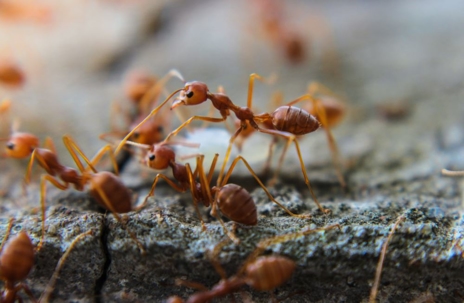Protecting Your Family from Fire Ants
Important Things to Know About Fire Ants & How to Get Rid of Them
Some of Georgia's most frustrating and sometimes dangerous pests are fire ants. Fire ants are so named because of their stinging bite that often feels like burning. These stinging ants are more than just a nuisance; they pose a serious health risk. Keep reading to learn more about these pests, including how to know if you have fire ants, how to identify them, and how to get rid of them.
What Do Fire Ants Look Like?
Your average fire ants are typically a red-brown color but may also be darker brown and even black. They grow to be approximately ¼ inch long. Their colonies can number in the hundreds of thousands. Each fire ant colony has a single queen, and female worker ants are responsible for maintaining the nest. Male drone fire ants breed with the queen, and when a new queen develops, some of the males will leave with her to form a new colony.
More facts about fire ants:
- They are most active during spring and early fall when temperatures are warm but not too hot (70-85°).
- They live in nests below ground, typically in open areas, like open yards, lawns, parks, or playgrounds, but they have been known to form floating nests on the water
- Nests appear above ground as mounds of earth, approximately a foot high and cone-shaped
- Fire ants eat a wide range of foods, including other insects, dead animals, plant life, and sweet foods
We are most concerned about red imported fire ants, which are a reddish color. This species is not native to the US and is incredibly aggressive. They were likely brought into the region from South America by accident in the 1930s. Since then, they have spread across Georgia and the southern US. Now, they can even be found as far away as Washington State!
Are Fire Ants Poisonous?
Fire ants are venomous, secreting a toxin called solenopsin. Fire ants bite the skin and hold on until the stinger injects the venom. A fire ant sting can leave you with welts and blisters that burn and itch. If you are allergic to fire ants, your reaction may be much more serious. You can also develop an allergy to fire ant stings if stung more than once.
Part of why fire ants are so dangerous is because they live in very large colonies. Consequently, when their nest is disturbed, and you are stung, you are typically stung by more than one ant. As one of the most aggressive ant species, red imported fire ants will swarm upon their victim. Each individual ant will also sting their victim repeatedly.
In particular, they pose a serious threat to small children who often step on them or their nests without realizing it. Children are also a lot more susceptible to the ants' venom and are less able to get the ants off of them and get away from the disturbed nest.
If you or your child were stung by fire ants and have an allergic reaction, you should seek emergency medical care as soon as possible.
Getting Rid of Fire Ants
Unlike the common fire ants native to the US, red imported fire ants are extremely difficult to eradicate. According to research performed at the University of Arkansas, it would take two full weeks of sub-10° temperatures to kill off an entire colony of red imported fire ants. Because they are so difficult to get rid of, if you suspect you have fire ants on your property, you need to reach out to an experienced pest control specialist, like Red Coat Pest Solutions, for help. Do not attempt to get rid of the ants on your own.
Until the fire ants are removed from your property, you should:
- Avoid their nest/s and mounds
- Keep children and pets away from the nest and mounds
- Always wear shoes and socks when outside
- Place signs warning visitors of the fire ant nest
According to the University of Georgia, the best time to exterminate red imported fire ants is in the fall. Entomologist Dan Suiter explains that by the fall, fire ant colonies have not only reached their peak population-wise, but they are in harvest mode as they prepare for the winter. This means that your fire ant exterminator can lay bait for the ants, which they will then carry back to their nest. Suiter also explained that the ants are less likely to spend much time deep in their nests during the fall, making it easier to treat the nest itself directly.
It is recommended that extermination be handled in two phases, first with bait and then with insecticide on the mount itself a week or two later. That being said, it is imperative that you work with a licensed pest control expert when dealing with fire ants. If you suspect you have a fire ant nest on your property, reach out to Red Coat Pest Solutions. We work with residential and commercial customers and can help you get rid of the fire ants for good.

